
On June 22, Denmark’s Ministry of Defense announced what companies would be building its next patrol ships. The new type of vessel is designed to be modular and upgradeable for years and even decades to come, allowing the same hulls and bones of the ship to serve even as the tools and technologies change with the times.
While Denmark is a small country, its possession of Greenland ensures it has an outsized role to play in the Arctic. With global climate change and thawing ice, the Arctic was already going to become a more trafficked and contested part of the globe. And that was before Russia’s invasions of Ukraine, first in 2014 and then at massive scale in 2022, put a deep freeze on cooperation between all of the Arctic states. As a founding member of NATO, Denmark has long been part of a defensive military alliance, ready to respond to Russian threats. New patrol ships will enable the country’s navy to operate more capably where needed for decades to come.
“A rethinking of the design will mean that we in the maritime domain are future-proof to handle changing needs. This applies, for example, to dealing with hybrid threats in a faster and more flexible way than before,” said Torben Mikkelsen, the head of the Danish Defense Ship program, according to Shephard News.
Observers expect the new patrol vessels will be based on a ship template called the OMT MPV80, built by Odense Maritime Technology and SH Defence. OMT is a naval design and advising firm—it’s one of the three major parts of the named consortium responsible for producing Denmark’s new patrol vessels, alongside Terma, a naval military contractor, and PensionDanmark, a pension fund.
The OMT MPV80 debuted at the DSEI arms exhibition in 2021. It was built with SH Defense’s modular “Cube” system as an essential characteristic. CEO of OMT Kåre Groes Christiansen told Naval News that they had made “a ship that was born Cubed.”
Cubed? Christiansen is referring to the Cube modular system, made by SH Defense. It is a system of packaging equipment in modules that are all designed to fit the footprint of shipping containers. The Cube modules are designed to fit on decks or into storage, letting existing vessels use the system. The OMT MPV80, designed for Cube utilization, will have spots for a Cube to be loaded through open side panels. Once the Cube system equipment is slotted in, the ship can use that equipment while underway, and then when it returns to port after a patrol or a mission, the crew can swap out what modules it carries.
Consider a ship designed for use with the Cube. Before it goes out on patrol, it could take on mine-laying modules, with shipping crate-sized mine storage and conveyor belts slotting in, letting the vessel turn the sea into an inhospitable domain, obstructing safe passage and protecting ports from hostile intrusion.
Alternatively, the same kind of vessel could be outfitted with mine-hunting modules. Storage, a work station, and launch space for mine-hunting underwater robots could fit inside a crate. Rather than build a control station for the minehunting robots into the body of the ship, a shipping container-shaped control room can plug in, letting the vessel work as a minehunter when it needs to be, but also letting it take on other missions at other times.
Other possibilities abound. The vessel could carry extra torpedoes, anti-air missiles, or depth charges for more of a naval combatant role. The Cubes could contain salvage arms and rescue boats, allowing the patrol vessel to serve more of a coast guard and life-saving role. With a base design that accommodates some deck guns for protection and a helipad to launch crewed and possibly uncrewed aircraft, the OMT MPV80 design seems well positioned to perform whatever Denmark might ask of it, alone or in support of allied navies.
The consortium’s announcement of the agreement for a new patrol vessel emphasized the modularity as a way to future-proof the ships. While naval operations entail risk, ensuring that the tools and equipment needed can be installed on the ships as soon as they are ready for use ensures that outdated weapons or sensors are unlikely to hinder such a ship.

These new patrol vessels are designed to replace Denmark’s existing fleet of Thetis ocean patrol ships, which operate in the icy waters around Denmark’s possession of Greenland and the Faroe Islands. These vessels are ice-rated, and entered service in the early 1990s. While sea ice has declined precipitously since then, it’s still a durable presence and risk in Arctic and near-Arctic operations. Designing for the future means designing for one where naval operations may follow the warming water north, and staying on the edge of the sea ice.
Watch a video about the type of vessel below:
The post Denmark’s new modular patrol boats will tackle a changing Arctic appeared first on Popular Science.
Articles may contain affiliate links which enable us to share in the revenue of any purchases made.
from | Popular Science https://ift.tt/ogASB73



0 Comments